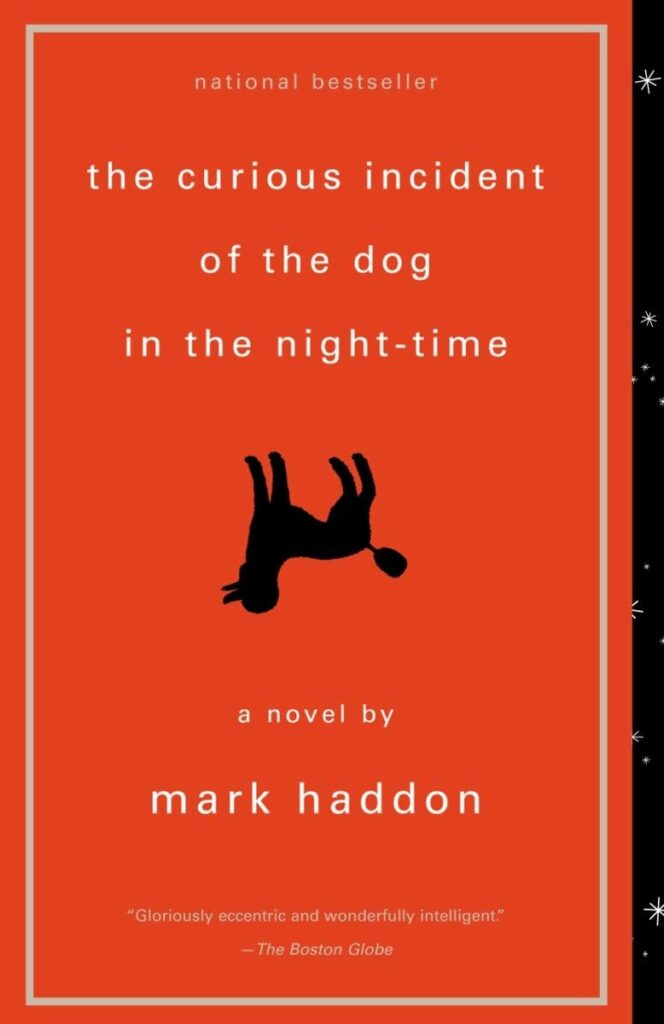In today’s post, we’re diving deep into Mark Haddon’s acclaimed novel, “The Curious Incident of the Dog in the Night-Time.” This modern classic has captivated readers with its poignant and humorous exploration of the world through the eyes of a young boy with autism, Christopher Boone. We’ll begin by providing an extended summary of the novel, offering insights into its plot, themes, and the unique perspective it brings to the reader.
Following that, we’ll introduce you to the key characters who play pivotal roles in Christopher’s life and his journey of self-discovery. And to round off our exploration, we’ll present a set of thought-provoking book club questions designed to spark in-depth discussions and reflections on this remarkable story. Whether you’re reading for the first time or revisiting this novel, our goal is to enrich your understanding and appreciation of Haddon’s work.
Related: A Jury of Her Peers Summary
The Curious Incident of the Dog in the Night-Time Summary
“The Curious Incident of the Dog in the Night-Time” by Mark Haddon is a striking and deeply moving narrative that cleverly intertwines elements of mystery, drama, and a coming-of-age story, all through the lens of a young boy named Christopher Boone. Christopher is no ordinary protagonist; he has autism, a condition that gives him a unique way of seeing the world, but also places him at odds with it. His life is structured around routines, facts, and a preference for the logical over the emotional, which often makes human interactions perplexing and overwhelming for him.
The novel opens with a mystery that immediately draws the reader in: the death of Wellington, a neighbor’s dog, found speared by a garden fork. This event propels Christopher on an unexpected journey far beyond the initial quest to uncover the culprit. Through his investigation, Haddon masterfully uses the structure of a detective story to delve deeper into Christopher’s character, revealing his struggles, strengths, and the way he processes the world around him.
Christopher’s condition means he perceives the world differently. He excels in mathematics and has a prodigious memory for facts, particularly prime numbers up to 7,057 and the capitals of all the countries in the world. However, he finds human emotions and social cues baffling, to the extent that physical touch and certain colors, like yellow, are intolerable to him. This detailed portrayal of Christopher’s perspective is one of the book’s most compelling aspects, offering readers a window into the thoughts and feelings of someone with autism, which is both enlightening and profoundly humanizing.
As Christopher delves deeper into the mystery of Wellington’s death, the narrative unfolds to explore themes of family, trust, and the challenges of navigating a world that often feels alien. The journey is as much about solving the mystery as it is about Christopher’s growth and self-discovery. He confronts and overcomes significant obstacles, not just in relation to the mystery, but also in terms of his personal development and understanding of his place in the world.
Photo: Amazon
Mark Haddon’s narrative style is distinct and engaging, utilizing Christopher’s voice to challenge conventional storytelling. The narrative disorients and reorients the reader, reflecting Christopher’s own experiences of disorientation and revelation. The book’s mix of suspense, humor, and poignant moments makes it a compelling read for a wide audience, providing both entertainment and insight into the life of someone with autism.
The Curious Incident of the Dog in the Night-Time Characters
In “The Curious Incident of the Dog in the Night-Time,” Mark Haddon introduces a range of characters that play pivotal roles in Christopher Boone’s life and his journey. Here’s a closer look at some of the key characters:
- Christopher John Francis Boone: The protagonist, a 15-year-old boy living with autism. Christopher is highly intelligent, especially in mathematics, but he struggles with understanding and relating to human emotions. He loves animals, detests being touched, and finds solace in the logical structure of the world around him. The story is told from his perspective, providing a unique insight into his thought processes and experiences.
- Ed Boone: Christopher’s father, who works as a heating maintenance and repair technician. Ed is a single parent, caring and patient, though he faces challenges in raising Christopher alone. His relationship with his son is tested throughout the novel, revealing layers of complexity and depth as the story unfolds.
- Judy Boone: Christopher’s mother, who is initially thought to be dead but is later revealed to be living in London. Her relationship with Christopher and Ed is a central element of the plot, adding emotional depth and conflict to the narrative. Judy’s character explores themes of motherhood, guilt, and redemption.
- Siobhan: Christopher’s teacher and mentor at school. She plays a crucial role in his life, providing guidance, understanding, and support. Siobhan represents a bridge between Christopher’s world and the outside world, helping him navigate social complexities and emotional challenges.
- Mrs. Shears: The owner of Wellington, the dog whose murder sparks the story. Her relationship with the Boones, particularly with Ed, introduces tension and intrigue, driving the plot forward.
- Mr. Shears (Roger Shears): Mrs. Shears’ ex-husband, who becomes a figure of suspicion in Wellington’s death. His past relationship with Judy Boone adds layers to the narrative, contributing to the family dynamics and emotional undercurrents of the story.
- Wellington: The neighbor’s dog whose death is the catalyst for the story. Though not a human character, Wellington’s death is central to the narrative, propelling Christopher on his investigative journey.
- Toby: Christopher’s pet rat, who serves as his constant companion. Toby represents a source of comfort and familiarity to Christopher, highlighting his empathy and care for animals.
The Curious Incident of the Dog in the Night-Time Book Club Questions
Here are some thought-provoking questions to spark conversation and reflection among book club members:
- Christopher’s Perspective: How does Mark Haddon’s portrayal of Christopher’s autism affect your understanding and empathy towards individuals with autism? What aspects of Christopher’s narrative voice stood out to you the most?
- Narrative Style: The novel is written from Christopher’s point of view, which offers a unique perspective but also challenges the reader in understanding the world from his standpoint. How does this narrative style influence your reading experience?
- Themes of Family and Relationship: Discuss how the book explores the themes of family dynamics and relationships, especially between Christopher and his parents. How do the revelations about his family affect Christopher and your perception of the characters involved?
- The Role of Trust: Trust is a central theme in the novel, particularly Christopher’s trust in his father and the people around him. How is trust built and broken throughout the story? What does the story suggest about the nature of trust?
- The Use of Mathematics and Logic: Christopher often retreats into the world of mathematics and logic to cope with the complexities of the world around him. How do these elements serve as a coping mechanism for Christopher? Do they offer a broader metaphor for understanding the world?
- Challenges and Overcoming Obstacles: The novel is as much a mystery about the death of Wellington as it is about Christopher’s personal journey and growth. Discuss the obstacles Christopher faces and overcomes. What do you think are his most significant achievements?
- Symbolism: The novel is rich in symbolism, such as the significance of prime numbers to Christopher and the metaphorical meaning of Wellington’s death. Discuss any symbols you found particularly meaningful or thought-provoking.
- The Ending: What are your thoughts on the novel’s ending? Did you find it satisfying? Why or why not? What do you imagine happens to Christopher beyond the scope of the book?
- Comparisons to Other Works: How does “The Curious Incident of the Dog in the Night-Time” compare to other novels you’ve read that deal with similar themes or are told from the perspective of a protagonist with a unique worldview?
- Impact on Readers: How has reading this novel changed or affected your understanding of people who experience the world differently? Has it influenced your perceptions of normalcy and disability?
Related: The Violin Conspiracy Book Summary
Final thoughts
Exploring “The Curious Incident of the Dog in the Night-Time” offers a profound glimpse into the mind of Christopher Boone, a character whose perspective challenges and enriches our understanding of the world. Through our extended summary, we’ve delved into the heart of the novel, uncovering the layers of narrative that make this story a modern classic. The characters we’ve met along the way, from Christopher himself to the family and friends surrounding him, add depth and complexity to the narrative, showcasing the diverse ways individuals navigate and interpret their environments. Mark Haddon’s novel is a journey into understanding the intricate tapestries of the mind and the myriad ways we all perceive and relate to the world around us.









